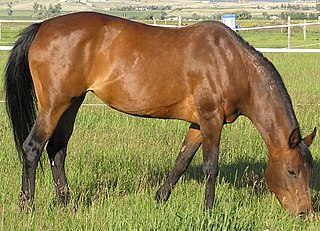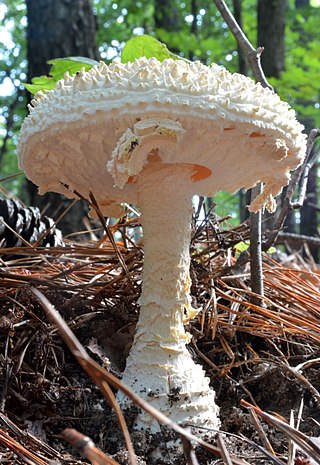
The fieldfare is a member of the thrush family Turdidae. It breeds in woodland and scrub in northern Europe and across the Palearctic. It is strongly migratory, with many northern birds moving south during the winter. It is a very rare breeder in Great Britain & Ireland, but winters in large numbers in the United Kingdom, Southern Europe, North Africa and the Middle East. It is omnivorous, eating a wide range of molluscs, insects and earthworms in the summer, and berries, grain and seeds in the winter.

Bay is a hair coat color of horses, characterized by a reddish-brown or brown body color with a black point coloration on the mane, tail, ear edges, and lower legs. Bay is one of the most common coat colors in many horse breeds.
Maroon is a brownish crimson color that takes its name from the French word marron, or chestnut. "Marron" is also one of the French translations for "brown".

The short-tailed blue or tailed Cupid is a butterfly that forms part of the family Lycaenidae. It is found from Europe to Japan and in India.

Auburn hair is a human hair color, a variety of red hair, most commonly described as reddish-brown in color. Auburn hair ranges in shades from medium to dark. It can be found with a wide array of skin tones and eye colors. The chemical pigments that cause the coloration of auburn hair are frequently pheomelanin with high levels of eumelanin; however, the auburn hair is due to a mutated melanocortin 1 receptor gene in Northwestern European people and by a mutated TYRP1 gene in the Melanesians and Austronesians, both genes that reduce the melanin production of the hair cells.

The grizzled giant squirrel is a large tree squirrel in the genus Ratufa found in the highlands of the Central and Uva provinces of Sri Lanka, and in patches of riparian forest along the Kaveri River and in the hill forests of Karnataka, Tamil Nadu and Kerala states of southern India. The International Union for Conservation of Nature (IUCN) lists the species as near threatened due to habitat loss and hunting.

Byasa latreillei, the rose windmill, is a butterfly from the windmills genus (Byasa), found in various parts of Asia, comprising tailed black swallowtail butterflies with white spots and red submarginal crescents.

The Hainan hare is a hare endemic to Hainan Island, China. The species was first described by Robert Swinhoe in 1870.

Amanita orientifulva, also known as the Asian orange-brown ringless amanita, is a species of agaric fungus found at altitudes ranging from 1,300–4,200 m (4,300–13,800 ft) in south-western China. It is associated with trees, especially Abies, Quercus, Salix, and occasionally Castanopsis. It fruits singly or scattered from June to September.

The band-winged nightjar or greater band-winged nightjar is a species of nightjar in the family Caprimulgidae. It is widespread in South America, where it is found in the Andes, Venezuelan Coastal Range, Santa Marta Mountains, Tepuis, most of Chile, Argentina, Paraguay, Uruguay and eastern Brazil. It occurs in a wide range of habitats, from the edge of humid montane forest to shrubby semi-deserts and urban rooftops.
The Red Sea cliff swallow, also known as the Red Sea swallow, is a species of bird in the family Hirundinidae.
The saddled swellshark is a rare species of catshark, and part of the family Scyliorhinidae, endemic to Eastern Australia. This bottom-dwelling species is found on the outer continental shelf and upper continental slope at a depth of 115–605 m (377–1,985 ft). It is a robustly built shark with a short, broad, flattened head and a capacious mouth. Adults are patterned with saddles on a brownish or grayish background, which varies between tropical and temperate sharks; juveniles are light-colored with many spots. This shark reaches 74 cm (29 in) in length. Like other swellsharks, it can inflate itself as a defensive measure. Reproduction is oviparous.
Psilocybe graveolens is an extremely rare psilocybin mushroom which has psilocybin and psilocin as main active compounds, discovered in the salt marshes or "meadows" of Hackensack, New Jersey. This mushroom is known for its strong and persistent odor.

Amanita aestivalis, commonly known as the white American star-footed amanita, is a species of fungus in the mushroom family Amanitaceae. The fungus is distributed in the eastern United States, south to Florida, and reaches north into the southeastern provinces of Canada. The cap of the fruit body is medium-sized, 5 to 8.5 cm in diameter and white. It sits atop a stem that is 8.5 to 16 cm long and has a rounded bulb at its base. The entire fruit body will slowly stain a reddish-brown color in response to bruising or aging. It remains unknown whether Amanita aestivalis is a distinct species from A. brunnescens, another similar Amanita with a comparable distribution. There are several other white-bodied amanitas with which A. aestivalis may be confused, including A. virosa, A. phalloides, and A. bisporigera.

Amanita ravenelii, commonly known as the pinecone lepidella, is a species of fungus in the family Amanitaceae. The fruit bodies are medium to large, with caps up to 17 cm (6.7 in) wide, and a stem up to 25 cm (9.8 in) long and 3 cm (1.2 in) thick. The warts on the whitish cap surface are large—up to 6 mm (0.24 in) wide and 4 mm (0.16 in) high. The stem has a large bulb at its base, covered with whitish to brownish scales, that may root several centimeters into the soil. The ring on the stem is thick and cotton- or felt-like. It is widely distributed in mixed and deciduous forests of the southeastern United States, where it grows solitarily or in groups on the ground in late summer and autumn. The mushrooms have a unique odor resembling bleaching powder.

Hydrelia flammeolaria, the small yellow wave, is a moth of the family Geometridae. The species was first described by Johann Siegfried Hufnagel in 1767 It is found in most of the Palearctic realm, from western Europe to Japan.

Amanita pachycolea, commonly known as the western grisette or the Stuntz's great ringless amanita, is a species of agaric fungus in the family Amanitaceae. It was recognized as a distinct species by mycologist Daniel Elliot Stuntz, and published in 1982 by Harry Delbert Thiers. Found in western North America, it associates with conifers in coniferous and mixed forests. Amanita pachycolea is classified in Amanita section Vaginatae, which includes species with conspicuous radial striations on the cap, inamyloid spores, and the absence of a ring on the stipe. The mushroom is edible, but not recommended due to possible confusion with toxic Amanita species.
Crocidura kegoensis, also known as the Ke Go shrew or Ke Go white-toothed shrew, is a species of shrew in the genus Crocidura described in 2004. It is smaller than other Crocidura species known from Vietnam, brownish-grey in colour with black markings on the muzzle. Its hair is short. The holotype was found in the Ke Go Nature Reserve, in Vietnam's Ha Tinh province, at an altitude of about 200 m.

Chhau-a-koe is a type of kuih with a sweet dough made with glutinous rice flour, sugar, and a ground cooked paste of Jersey cudweed or Chinese mugwort. The herbs give the dough and the finished kuih a unique flavor and brownish green color. The kuih is found in Fujian, Hakka, and Taiwanese cuisine.

Amanita spreta or the hated amanita is an inedible species of the genus Amanita.














